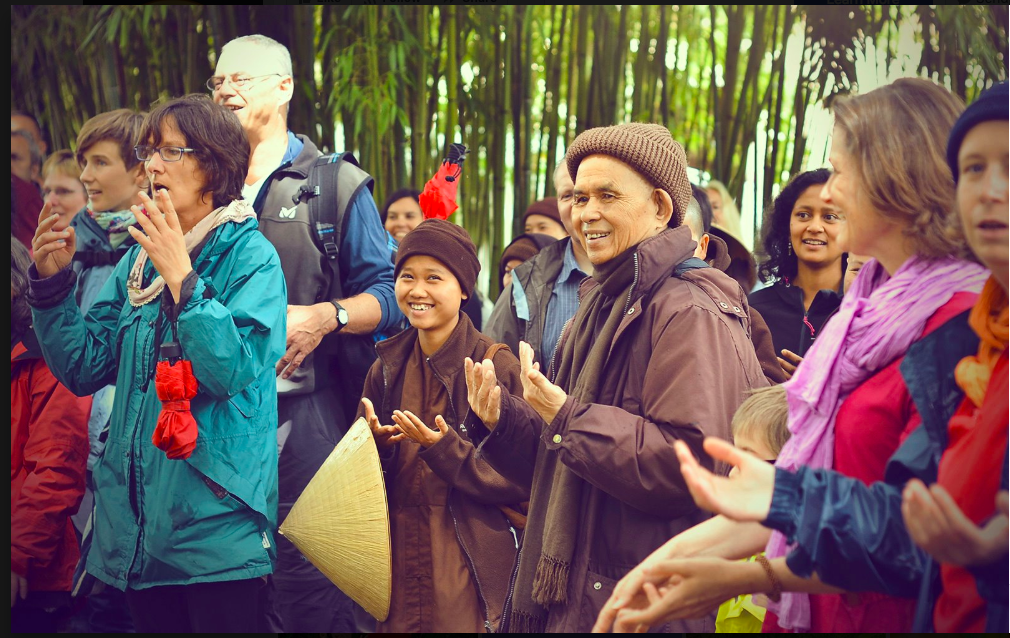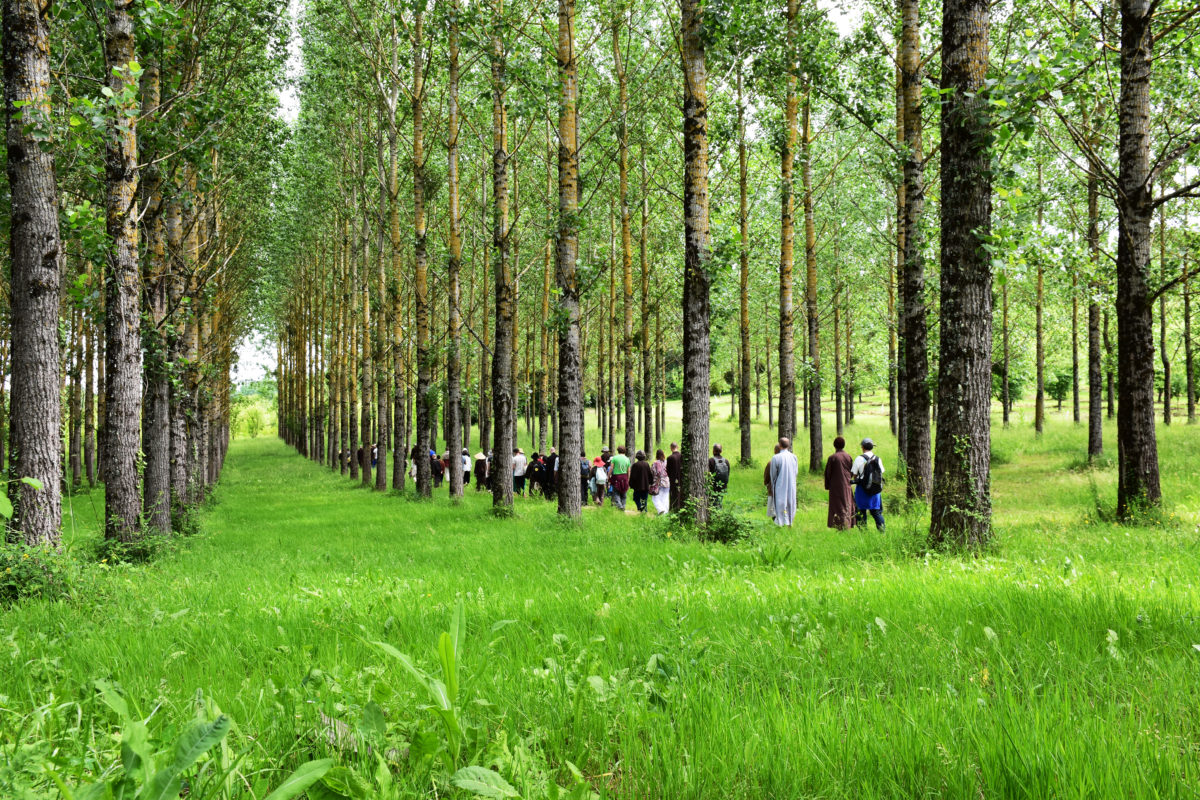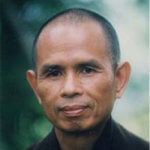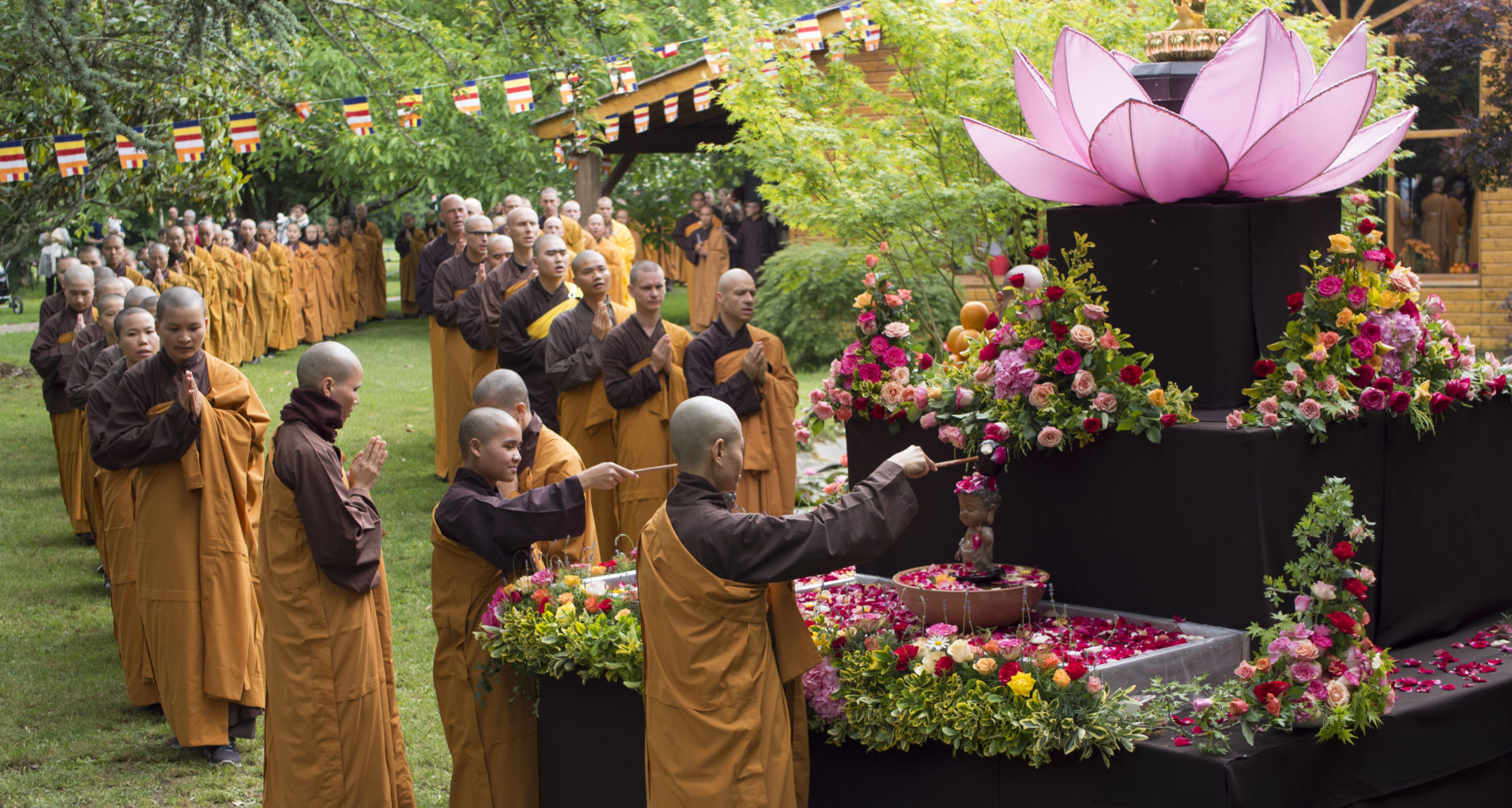By Thich Nhat Hanh in October 2018
Thay offers a Dharma talk on touching the positive, refreshing, healing elements in life.

Good morning, dear Sangha. Today is March 19th in the year 2006. We are in the Lower Hamlet during our Spring Retreat.
The practice of Buddhist meditation helps us to get the right nourishment.
By Thich Nhat Hanh in October 2018
Thay offers a Dharma talk on touching the positive, refreshing, healing elements in life.

Good morning, dear Sangha. Today is March 19th in the year 2006. We are in the Lower Hamlet during our Spring Retreat.
The practice of Buddhist meditation helps us to get the right nourishment. In the sutra on the Full Awareness of Breathing, the Buddha proposed this exercise of nourishment: Breathing in, I experience joy; breathing out, I experience happiness. We need to be nourished by joy and happiness in our daily life. Breathing in, I feel nourished by joy; breathing out, I feel nourished by happiness. This is not the practice of autosuggestion; it is how to generate the feeling of joy and happiness.
When we are well established in the present moment, we can get in touch with the positive elements of life that are in us and around us. We have to know how to select the positive elements, because there are also negative elements within us and around us. If we keep getting in touch with these negative elements, we will not get the joy and happiness that nourish us. That is why beginners have to learn how to get in touch with the positive, refreshing, healing elements within and around us. It can be easy to do with the support of the Sangha.
The Five Mindfulness Trainings are complete ways of practicing mindfulness that get us in touch with the positive, refreshing, healing elements in life. The Fifth Mindfulness Training is about mindful consumption. We are what we consume so we need to select items of consumption that can bring us joy and happiness.
Joy is born from an awareness that happiness is possible. Let us visualize a person who walks in the desert and is very thirsty. He does not have any water to drink and is going to die. Suddenly, he sees an oasis ahead, and he knows that when he arrives there will be trees for shade and a pond of water to drink. When he arrives at the oasis and sees the pond of fresh water, although he has not drunk the water yet, he feels joy. The positive elements in you and around you can nourish you, and the feeling of joy is born from that contact. Then he kneels down, scoops up the water, and begins to drink. The feeling he gets while drinking is happiness. So there is a difference between joy and happiness.
The Practice of Young People
Many young people visit the Plum Village website and have written that they love to practice the Five Mindfulness Trainings. They know the trainings help protect them from taking in the wrong kinds of nutriments. But when they live alone, it’s difficult to practice the five trainings because there is a tendency in them to touch objects of craving. So when they ask how to practice, we say that to really practice the five trainings you need the support of the Sangha. When you live with other members of the Sangha, you are supported by collective energy, and the Five Mindfulness Trainings become easy for you to practice. It’s nice to stay together. When you hear the bell, you get up at the same time, you go to the sitting at the same time, you go to lunch at the same time, you go to sleep at the same time. It’s very easy. If you live alone, it’s more difficult.
Humans are social beings and should live together. When you look at a formation of birds flying in the sky, you see the beauty of the birds. Flying together, they rely on each other and make use of collective energy. Each bird is flying in its position and feels the other birds flying at the same time. They feel supported and they need to expend less energy.
When we live in the Sangha, we see our position in the Sangha. We realize that other members of the Sangha are there. We know that we can get the support of the collective energy of the Sangha. And whatever is difficult when you are alone is no longer difficult when you live with a Sangha. So we advise young people to live together as a Sangha. The family can be organized as a Sangha. University students can organize themselves as a Sangha. We all need a Sangha. In the Sangha, we can practice the Five Mindfulness Trainings much better.
Mindful Breathing
The Buddha said that before he became fully enlightened, he enjoyed the practice of mindful breathing. It helped him to be relaxed and free and not to get tired. That’s why after having become fully enlightened, he continued to practice mindful breathing. He recommended this practice to all his students.
When you practice mindful breathing while walking, you get in touch with the Earth. You feel that the Earth is your mother, the ground of your manifestation. You get in touch with the trees, the birds, the flowers, the grass. You get in touch with the clouds, the blue sky, with nature. And when you get in touch with them, you get the nourishment you need. Many people see the sky, the river, or the trees, but they do not get the nourishment they need because they are not mindful. They are not fully present in the here and the now.
Mindful Journalism
Many years ago, a journalist from the San Francisco Chronicle met me at a monastery in Northern California. He planned to write an article on the practice of mindfulness. I invited him to sit in the shade of the redwood trees, and I offered him tea. I said, “You can forget the article and just enjoy the tea with me.” He was willing to participate, so we focused our attention on the redwoods, the blue sky, the birdsong, the tea, and we did not talk about mindfulness. We tried to be mindful, to enjoy being together with the redwoods. Because of that practice of having tea together and getting in touch with the wonders of life, he was able to write a very good article. During our time together, he was able to forget about the article; that is why later he could write a very good article.
As I walked him to the parking lot I suggested he practice mindful walking, enjoying every step. Halfway there, I invited him to stop and look at the sky. The sky was very blue. Breathing in, I’m aware of the sky. Breathing out, I smile to the blue sky. After one minute of practice he looked at me and said, “I have never seen the sky like this.” Because he was really present, he truly saw the sky for the first time.
I have met with journalists in Europe, in America, in Asia. I always invite them to practice mindfulness. I tell them that as a journalist, when you write with mindfulness, with the capacity of listening deeply, with the capacity of getting in touch with the positive elements, you can write good articles and help many people water seeds of joy and happiness in them.
There are many articles published that water the seeds of fear and anger in the hearts of readers. You don’t want to do that; as a journalist you want to help. You want your article to water the seeds of compassion and understanding in the consciousness of your readers. Even if you report about negative things happening in the world, when people read your article they are nourished by your compassion and your understanding. Every report, every article can be a means to water the seeds of compassion and understanding in the minds of your readers.

Nourishing Ourselves with Joy and Happiness
Meditation practitioners should receive the nourishment of joy and happiness every day. These elements are already within you and around you. Within you there is the intention to help, to love, to protect, and it needs to be watered. Living together, we can help each other nourish this intention. You acknowledge the existence of the intention to love, to forgive, to protect in your brother, in your sister. And when you water the seeds of understanding and compassion in the other person, you water the seeds in you; that is a deep practice. As a Sangha, we go like a river. We support each other in the practice. Joy every day. Happiness every day. The practice provides us with joy and happiness in the morning, at noontime, and in the afternoon. We don’t have to buy these things at the supermarket; the practice provides us with these elements.
It’s wonderful to be alive and walking on Earth. You don’t need money and power or fame to do that; you need only mindfulness. When you breathe in mindfully, you realize that you are alive and that you are walking on Earth. Master Linji said that walking on Earth is a miracle. When the Buddha walks, he enjoys every step he makes. Each step is healing, is nourishing. When you walk like that, you walk with the feet of the Buddha. There’s a Buddha in you that needs to manifest. When you walk that way together you consume joy and happiness. And if you are able to walk like that in Plum Village, you can walk like that wherever you are: in a supermarket, in the railway station, or in the airport. You walk like a free person.
Many in our society are not able to walk like that. They are so busy. There’s a tendency for us to rush. We don’t have time to live. We might have more money than our ancestors, but we do not have more time. We believe that time must be used to make money. But time is life. We need to ask how to live a simpler life so that we can live more deeply every moment. Coming together as a Sangha, we can do that. We have to resist the tendency to run, to burn up our life. We have to come together and resist, to organize our life in such a way that make joy and happiness possible in the morning, at noon time, and in evening.
Of course, there are negative things like fear, anger, worries. But if you know how to get the right nourishment, you will be healthy and strong enough to take care of these negative things. And if you know how to make use of the collective joy and happiness of the Sangha, you can easily take good care of the negative factors within you.
We know that our mental formations like joy, happiness, compassion, as well as our fear, our anger, our despair—they are all organic. So it is possible to transform the negative elements into positive elements. Looking at the negative elements you are able to understand, and that understanding will bring about acceptance. Understanding can transform anger and fear into compassion.
Our consciousness is like a garden where we plant mental formations. When we do organic gardening, the garbage produced by the garden can be used to make compost so that it can nourish the flowers and vegetables. And as flowers and garbage are both of an organic nature, our mental formations are also like that. If we know how to handle our fear, our anger, our despair, we are able to transform them back into understanding and compassion. We can learn a lot from our own suffering. We can transform the garbage into vegetables and flowers. You don’t need to throw it away. You don’t need to suppress anything, because like plants in our garden, our mental formations are often organic in nature.
The Four Nutriments
The Buddha spoke about four kinds of nutriments. It is possible for us to practice mindful consumption as a Sangha. Mindful consumption is to consume only healthy, refreshing, and healing elements.
EDIBLE FOOD
The first kind of nutriment is edible food. The Sangha decides to buy only the kinds of food that will not bring sickness to our body and our mind. In the tradition, before you eat, you practice the Five Contemplations. You visualize where the food has come from. You know that there are certain kinds of food you need to refrain from consuming. You make the vow to eat only the things that will nourish you and prevent illness. You realize that it takes much hard work to create and deliver the food. And you want to water the seeds of gratitude and joy while eating this food. So the Five Contemplations remind you of mindful consumption as far as edible food is concerned.
In the family, you should organize at least one meal a day where everyone can sit together. We can rewrite the Five Contemplations so that children can understand, and a young boy or girl can read these five contemplations before eating. Then everyone can eat in silence for five minutes, and it will become a habit, a tradition. When we go to the market to buy food, the children can come along. While shopping, we can show them what kinds of items they should buy and what to avoid, and explain why. That is the teaching of mindfulness.
SENSORY IMPRESSIONS
The second source of nutriments is sensory impressions. You consume through the eye, the ear, the nose, the body, and the mind. Sometimes we do not want to consume, but we consume anyway. The sights and sounds we get in touch with while we cross the city are the objects of our consumption, and we often take in the wrong nutriments. Reading an article, viewing a film, or listening to a conversation can bring a lot of toxins into our body and mind. We have to practice mindfulness so we don’t consume these toxins.
Suppose someone has a conversation with us that is full of anger, of fear, of violence. If we sit and listen, and the conversation is watering the seeds of anger and fear and craving in us, we have to stop and say, “Dear friend, we practice mindfulness of consumption. We don’t want to listen and talk too much about these negative things. We want to take in good nutriments.”
Reading newspapers and watching the news is also consumption. There’s so much violence and despair in the news that we view every day. We have to decide not to water the seeds of violence and fear and despair in us. We don’t want to be cut off from the world; we want to know what is going on. But we don’t need to read newspapers and watch television every day. The positive elements should be reported more. If someone is murdered, it is reported right away. But if the daffodils are coming up, it’s not reported. If a retreat of five hundred people has stopped driving their cars for five days, that is very good news. But it isn’t reported.
To nourish compassion is a wonderful practice of consumption. We become more relaxed and are immune to many kinds of disease. When you are angry and tense, you may get sick. But if you are full of compassion you can smile, you can forgive. You will not become a victim of sickness, so compassion protects us. Not only from anger, from fear, from unhappiness, but it also protects our body from sickness. That is why we should feed our compassion every day.
The Buddha is referred to as the Compassionate One because he understands the suffering of living beings. When you have this understanding, you don’t blame anymore; you don’t get angry. Compassion comes from the capacity of looking at living beings with the eyes of understanding. When you have the time to listen deeply and to look deeply, you will understand. To consume understanding and compassion will make us healthy both mentally and physically.
As a Sangha, we should have ways to nourish our understanding and compassion every day. That understanding and compassion should be directed to us and to the people around us in the Sangha. We learn to understand ourselves and have compassion for ourselves. We don’t blame or judge ourselves. The insight of nonself helps us understand the people in the Sangha. Sometimes a member of the Sangha is not kind in his way of speaking or acting. But if you understand the reality of nonself, you will see that person was conditioned this way from childhood. When we understand, we don’t get angry or blame. To learn to look at people with understanding and compassion is the most wonderful practice. When we look at our brothers and sisters in the community with the insight of nonself, we can accept them and understand them easily. We can embrace them with our understanding and compassion. This is crucial in helping that person to transform.
As a joyful Sangha, a compassionate Sangha, you can be a refuge for so many people. If you do not have understanding and compassion for yourself and for the people in your Sangha, you cannot expect to offer a lot of compassion and understanding to the world. So you and the Sangha are the objects of your practice every day.
VOLITION
The third source of nutriments is volition––your intention, your desire. Each person is nourished by his or her desire. There are kinds of desire that destroy you, that can bring you to dark destinations, but there are desires that can bring you to the Kingdom of God, to the Pure Land of the Buddha, to the realm of happiness and peace. So we have to look deeply to see what the deep desire is in us. We might think that fame and wealth and power and sex are necessary for our happiness. Many believe that happiness is not possible without these things. But if we look around us with mindfulness, we notice that there are people who have plenty of power and suffer so deeply. There are those who have plenty of fame and suffer very deeply, and many of them have committed suicide. Many political leaders have great power but experience hell every day.
The nutriment that we need is a wholesome desire: the intention to live happily, the intention to live deeply every moment of our daily lives, the intention to transform ourselves, the intention to help and to protect living beings, the intention to set up a Sangha, to help many people transform. All these kinds of desire are wholesome. It is the third kind of nutriment spoken about by Buddha.
Each of us should look deeply to identify our real intention, our deepest desire. To see whether that desire, that intention, is bringing us to the realm of suffering or happiness. The Buddha had a deep desire. His desire was to transform himself and to help many people. If we have the same kind of desire, we can be like him and we can be happy; we can be peaceful, and we can help so many people.
CONSCIOUSNESS
The last kind of nutriment is consciousness, consciousness as food. When there are elements of wisdom and compassion, happiness and peace are possible. Consciousness still has elements of ignorance and anger, but with the practice, we can remove all afflictions and wrong perceptions, and consciousness is discovered as wisdom. Wisdom is the consciousness of enlightened people.
There is individual consciousness and collective consciousness. If we are with people who are loving, understanding, and good, then every day we’ll be nourished by their collective energy. If we live close to people who think good things, say good things, and live a good life, we will share in their life and get wholesome collective energy from them. But if we live with people who are violent, who are full of craving and despair, we will become violent and despairing, victims of craving, and so on. That is why it is important to be affiliated with good healthy people. If you have the chance to live in a Sangha where people know how to get in touch with the positive elements of life, refraining from unmindful consumption, then the fourth category of food––consciousness––will be positive.
Many of us believe that it is our genes that decide whether we’ll be happy or unhappy, healthy or unhealthy. This determinism should be reexamined. Our environment helps turn on the good things or the bad things in us. If we live in a good environment, receiving good nutriments as collective consciousness, then the good elements in us will have a chance to be turned on. That is why the environment is so important.
Let us organize our lives in such a way that we can get in touch with good people and a good environment. That is why Sangha building is so important. We need to be in a good environment. We need our children to be in a good environment so they are protected. We have enough intelligence to create an environment so that the four kinds of nutriments that we really need will be available, and we can be protected by the practice of the Fifth Mindfulness Training, mindful consumption.
TRANSCRIBED BY DIANE F. WYZGA. EDITED BY GREG SEVER AND BARBARA CASEY.


